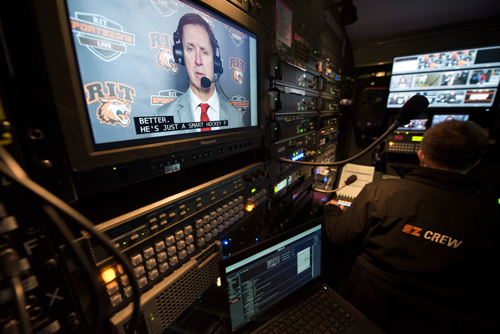It’s no coincidence that captioning is a priority to Rochester Institute of Technology (RIT): home to the National Technical Institute for the Deaf (NTID), the university was instrumental in establishing America’s first closed captioning standards.
“Everything that our group does — live broadcasts, streaming, production and post production – is captioned,” says James Bober, Assistant Director, Chief Engineer for University Production Services, the Marketing Communications Division at RIT. “That commitment extends to live events. Real-time open captioning is provided for our audience at every major sporting event, as well as a wide range of speaking engagements, lectures, presentations, entertainment, and more.”
Speed and Security
EEG solutions are central to RIT’s promise of comprehensive captioning on campus. The university’s full HD production capabilities depend on six EEG HD492 iCap encoders providing easy 24/7 connectivity to thousands of certified caption partners worldwide via iCap, EEG’s Emmy Award-winning Cloud powered caption network.
“I had always felt that an IP-based solution was needed to connect with captioners, and when EEG introduced their iCap System it was the right product at the right time,” Bober says. “By implementing real-time captioning over IP in a secure environment, EEG created a system that fit our needs perfectly.”
For Bober, the benefits of iCap combined with the EEG HD492 are crystal clear. “Speed and reliability are their hallmarks,” he states. “Once we adopted iCap, noisy phone lines and dropped connections became a thing of the past. It also affords us extreme versatility: iCap is capable of connecting with multiple units, bridging systems, plus outputting directly not only into encoders but Web streams. It’s all there.”
With RIT constantly expanding the scope of what it captions, Bober and his team are also considering future applications for EEG’s Lexi Automatic Captioning cloud-based platform. Lexi is capable of delivering over 90% accuracy for many common media types, creating a new standard in accessibility for addressing currently uncovered live material in broadcasting, corporate, education, government, and more.
“There’s a fair amount of expense involved with having a live captioner online,” Bober notes. “The Lexi ASR solution would make it economically feasible to open captioning services up to even the smallest on-campus events.”
Captioning Beyond Compliance
At a university where accommodating the hard-of-hearing goes far beyond meeting ADA compliance requirements, EEG captioning solutions help them to uphold the very highest standards. “Captioning is a daily part of our lives here at RIT,” James Bober says. “EEG ensures that our captioning always works flawlessly.”
###
About RIT:
Rochester Institute of Technology is home to leading creators, entrepreneurs, innovators and researchers. Founded in 1829, RIT enrolls 19,000 students in more than 200 career-oriented and professional programs, making it among the largest private universities in the U.S.
The university is internationally recognized and ranked for academic leadership in business, computing, engineering, imaging science, liberal arts, sustainability, and fine and applied arts. RIT also offers unparalleled support services for deaf and hard-of-hearing students. The cooperative education program is one of the oldest and largest in the nation. Global partnerships include campuses in China, Croatia, Dubai and Kosovo.
To learn more, visit: www.rit.edu

